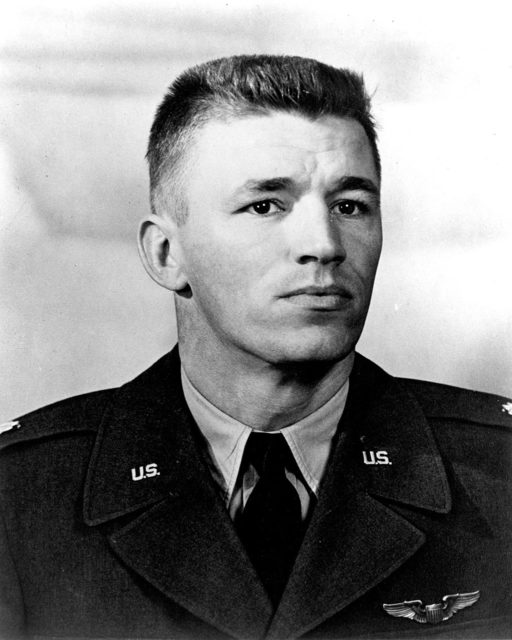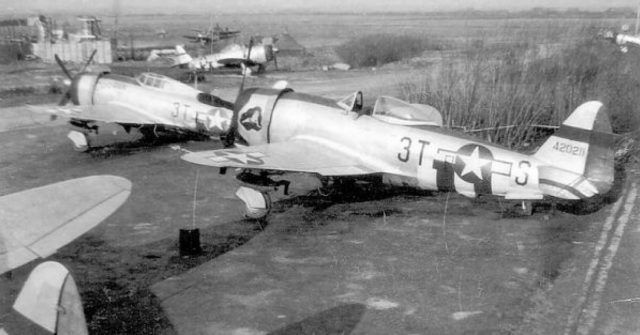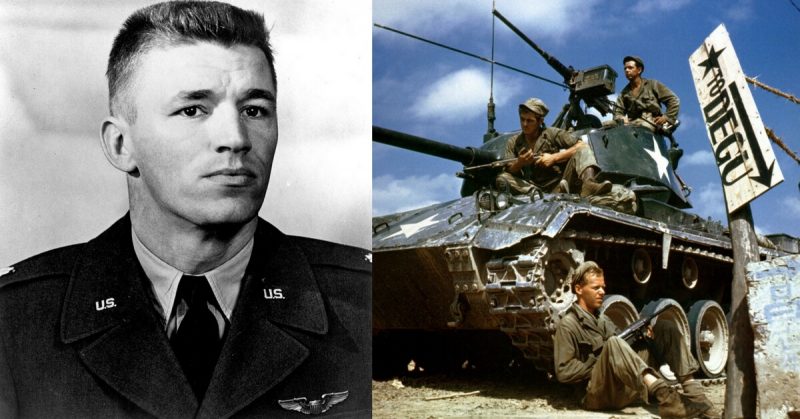When people speak of a plane recklessly and intentionally diving into an enemy, the word Kamikaze comes to mind. A desperate tactic deployed by the Japanese in WWII; it struck fear into the hearts of those in its path. In the Korean War, it was an American WWII veteran and fighter pilot who used the tactic. Chinese troops in Korea had amassed a heavy artillery barrage on a ridge and were pinning down United Nations forces, and pilot Charles Loring was called to assist.
From WWII POW to Korean Hero
Charles J. Loring Jr was born on October 2, 1918, in Portland, Maine to a typical American family. Shortly after America entered WWII, Loring enlisted in the US Army. In March 1942 he joined the Army Air Corps and by May was a cadet. After extensive training, he graduated with a commission as a Second Lieutenant in the Army Reserve.
In December 1942, he was assigned to 22nd Fighter Squadron, 36th Fighter Group, Ninth Air Force based in Puerto Rico. He flew anti-submarine aircraft defending the Panama Canal and areas of the Caribbean. In April 1944, as the war progressed, Loring and the 36th Fighter Group were sent to England in preparation for the greatest amphibious invasion ever. They were involved in reconnaissance, fighter escort and bombing missions to strike strategic targets in Europe.
Following the success of D-Day, Loring continued to fly sorties in support of the advancing Allies. By December 1944, he had flown 55 combat missions and had been awarded the Distinguished Flying Cross for his actions in destroying ten German armored vehicles. However, his war experience came to an abrupt end when he was shot down over Belgium. He spent the following six months as a POW until he was liberated on May 5, 1945. However, his experience with war was far from over.

A Final Flight
Despite his harrowing experience of being shot down and time as a POW, Loring remained in the renamed US Air Force and was promoted to Captain. Although the Korean War broke out in June 1950, he continued working at Air University until February 1952 when he was assigned to 8th Fighter-Bomber Wing, Fifth Air Force, to supervise pilot training in South Korea.
In July he returned to combat missions as Operations Officer for the 36th Fighter-Bomber Squadron. There he flew an F-80 Shooting Star jet aircraft conducting close air support missions for UN ground troops. In just four months, Loring completed over 50 combat missions as the war in Korea dragged to a stalemate along the 38th Parallel.
In November the focus of the UN targets revolved around two locations known as Triangle Hill and Sniper Ridge. The Chinese had assembled a large artillery battery on the hill including 133 large caliber guns and 24 BM-13 rocket launchers which were wreaking havoc on the UN ground forces. Adding to the peril, they had also amassed a contingent of 47 anti-aircraft weapons to defend their artillery. It was the largest Chinese artillery operation during the Korean War.
When the mass of weaponry had been spotted Loring, and three other F-80s were called in to bomb them. As usual, Loring took the lead on the bombing run lining up the artillery in his path. However, the Chinese troops manning the anti-aircraft guns had been exceptionally well-trained, and their firing was extremely accurate even at a distance. Loring’s plane sustained significant damage to its fuselage which disabled the aircraft. The pilots of the other F-80 planes radioed to Loring to turn back and abort his mission.

Giving All for Others
Instead, Loring ceased radio contact and continued on his bombing run. As he approached the artillery batteries, he was continuing to take significant fire. At 4,000 feet Loring deliberately accelerated and then took a 40-degree angle directly towards the ground batteries as his wingmen looked on in horror. Speeding up with what little control he had of his damaged aircraft, Loring dived straight into the enemy battery position exploding on impact and completely destroying it.
Loring was killed instantly in a blaze of glory. His wingmen could not believe what they had witnessed and when they reported his conspicuous gallantry it was clear the nation’s highest military honor had been earned. His action that day saved countless numbers of UN troops.
In 1954, President Eisenhower presented Loring’s widow with his Medal of Honor while announcing a new Air Force Base in Maine would be named in honor of her husband’s noble spirit, superlative courage, and conspicuous self-sacrifice.
